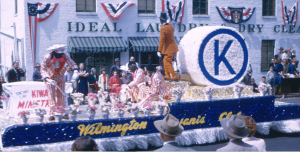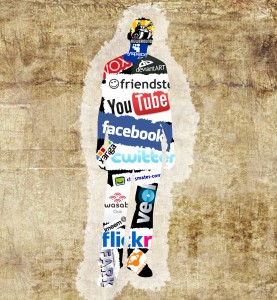I’m currently teaching a section of HIST395, our department’s mandatory research methods course for History majors. We normally offer four or five sections a semester and use a shared syllabus. Over the summer, a colleague proposed that we add a new element: a required WordPress site. In addition to the usual research paper, exams, oral presentation, and other assignments, each student in each of the four sections will create his or her own domain–a place to post papers, a resume, photos, random musings, whatever. I’m familiar with WordPress, but I confess to feeling
Author Archives: Meg
HIST 395 Pilot Underway

Image #47-1953, Azalea Festival Collection, New Hanover County Library Digital Collections
This semester (Fall 2014), students in all four sections of HIST 395: Research Methods will participate in a pilot project. Each student will create an individual domain via WordPress that will serve as a portfolio site. Today they will make their first “real” posts, which should consist of a primary source used in their papers plus a brief analysis of said source. I’m posting this image from my own research to illustrate the goal. It is used in chapter four of a book manuscript titled, “Deep Currents: Race, Place, and Memory on Wilmington, North Carolina.”
Taken in 1953, it shows members of the Wilmington (NC) Kiwanis Club on their float in the city’s annual and much celebrated Azalea Festival. It clearly shows four men in blackface, the ‘Kiwanis Minstrels.’ One of them wears a top hat and a bold, golden-yellow plaid suit; the other three wear outlandish red-and-white striped suits with oversized red bow ties. In earlier chapters, I explore how and why minstrelsy became popular in the 1830s and 1840, why it appealed to white residents, and how its unique forms and tropes persisted into the twentieth century. Through their costumes and antics, the white men on this float deployed old stereotypes of blacks as ignorant buffoons tolerable only for their entertainment value. The Kiwanans’ own place in society, derived by way of cultural inversion, is as the community’s enlightened governors. That such a prominent organization represented its identity this public way confirms the prevalence of racist attitudes among white civic leaders in the 1950s and their conviction that the audience (which they imagined as white) shared their views. In these and other ways, I argue that the Azalea Festival helped perpetuate the ideal of white supremacy and the illusion of “harmonious” race relations.
You CAN go home again . . .
On March 27, 2014, I gave an author talk, “Black Powder, White Lace – The du Pont Irish and Cultural Identity in Nineteenth Century America”
When my old friend Roger Horowitz first invited me to give an author talk at Hagley Museum and Library, I immediately said yes, but I’ll admit that I didn’t really know what to expect. Imagine turning your scholarly book into an hour-long lecture for the general public! It turned out to be one of the best presentations I’ve ever done, not just because some family and friends were there, but because so many strangers came up afterwards to share with me their stories, their genealogies, their thanks. One man, a Hagley guide, brought the copy he purchased back in 2002 for me to sign. It was all dog-eared and full of underlinings and marginalia. And that’s really what I always wanted—a book that regular people would read and enjoy. About twice a year, someone reads Black Powder, White Lace and tracks me down via Google to say hello or ask if I have more information about an ancestor or whatever. I’m always grateful and humbled when they do that. But it was so much nicer to meet my readers (past and future) in person.
Hagley has just posted the video of my talk. You watch the whole thing here:
Student Privacy Concerns in a Web 2.0 World
I’ve been thinking about student privacy a lot over the past two years. The digital exhibit site my students created, Madison in the 1970s, is somewhat like a blog. Blogging, of course, is a particular kind of writing and publishing. Blog posts tend to be informal, chatty, polemical, self-published, and footnote-free–all the things traditional academic writing is not. Blogs are also public. Anyone can find and read what has been posted, and the poster will likely never know who has read her work, let alone how different readers reacted. In another post, I will explore how and why I held my students to disciplinary standards of writing, research, and citation (despite the blog format). Here, I lay out why requiring an undergraduate to create or contribute to a blog (or other digital project) raises important ethical considerations, especially as related to questions about students privacy and students’ rights to their own work in a Web 2.0 environment. I remain committed to the benefits of digital projects, but recommend a cautious, thoughtful approach. Continue reading
“Getting Started” on #dighums at CFI
On Wednesday, I am co-presenting at May Symposium, an annual faculty development event, to help colleagues “get started” with digital technologies in the humanities and social sciences. Our session, organized by Chris Arndt, will feature hands-on opportunities to play with Google Drive, WordPress, and Google Earth. Many people on our campus are dabbling with digital projects, but others doubt the pedagogical effectiveness of certain applications or worry about the investment of time and energy needed. Our goal is to allay some of these concerns by demonstrating and discussing how we have successfully used digital technologies in our own classes. Other presenters are: Chris Arndt, Kevin Hegg, Andrew Witmer, and Kevin Borg.
Here are some links I will be using in my portion of the session:
http://people.jmu.edu/mulroomm/meghome/ (my old antiquated site from the early 2000s) and http://sites.jmu.edu/mad70s/ (my new class project). Continue reading
Public History & Me
I’ve been working in and around public history for nearly 30 years. As an undergraduate, I worked at the Center for Historic Architecture and Engineering at the University of Delaware. My job at that time was to measure and draw historic buildings for collections associated with the Historic American Buildings Survey/Historic American Engineering Record Divison of the National Park Service. After graduation from UD, I was hired on to a HABS/HAER summer team that surveyed industrial sites in Continue reading
Will the Real Dolley & Jimmy Please Stand up?
The Madisons are big on this campus. There are two cats, for example, that hang out on the Quad and the students have named them . . . yup, Dolley and Jimmy. Images of James Madison are especially prominent: there are two statues, Big Jimmy (on east campus) and Little Jimmy (near my building). There are stylized Jimmy heads on our website, on the doors of official university vehicles, on t-shirts, Powerpoint templates, stationary, posters, and so on.We even had our own first-person interpreter, an undergraduate who dressed the part and delighted the community as she (yes she) walked around campus in tricorn and breeches. Most of these representations, interestingly, portray Madison as the father of the Constitution, a vigorous man in his prime. Dolley is far less visible, but no less beloved. I recently learned that there is an award named for her: students nominate each other for Dolley Leadership Awards in categories like Outstanding Student Organization and Outstanding Program/Event. Continue reading

